Welcome to the world of email marketing, where businesses connect with their audience personally and engagingly.
Imagine this scenario: You start your day by waking up, preparing a steaming cup of coffee, and eagerly reaching for your email inbox to find a delightful email waiting for you. It’s not just any email; it’s from your favourite brand, sharing exciting updates, exclusive discounts, and valuable content. That’s the magic of email marketing!
Benefits of Email Marketing
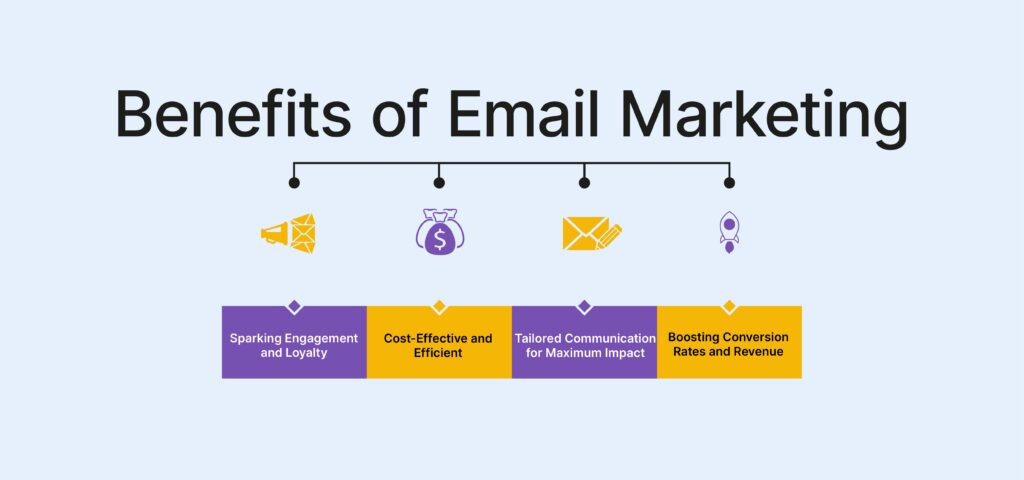
Email marketing goes beyond simply sending messages to a random list of email addresses. It’s about building relationships, fostering engagement, and driving conversions. Now, let’s explore some of the remarkable benefits that make email marketing a must-have tool for businesses:
1. Sparking Engagement and Loyalty
Imagine receiving an email that feels like it was personally written for you. That’s the power of email marketing. By delivering targeted and personalised emails, businesses can establish a direct and personal channel of communication with their audience. It’s an opportunity to connect, interact, and receive valuable feedback. This engagement leads to stronger brand loyalty, as customers feel appreciated and understood.
2. Cost-Effective and Efficient
Gone are the days of expensive print or TV ads. Email marketing offers a cost-effective solution to reach a large audience with minimal investment. With the help of automation tools, businesses can efficiently manage and scale their email campaigns, saving time and resources. It’s a win-win situation for both enterprises and subscribers.
3. Tailored Communication for Maximum Impact
One size only fits some in email marketing. By segmenting their email lists based on demographics, preferences, or past interactions, businesses can deliver tailored content that resonates with specific subsets of their audience. It’s like conversing with each subscriber, addressing their unique needs and interests. This personalised approach significantly increases the chances of conversions and success.
4. Boosting Conversion Rates and Revenue
Every business wants to see results. Email marketing possesses significant power in stimulating conversions and boosting conversions. Companies can guide recipients towards desired actions by crafting compelling email content, including clear call-to-action buttons, and utilising personalised recommendations. Whether it’s making a purchase, signing up for a webinar, or downloading an e-book, a well-executed email marketing campaign can significantly boost conversion rates and revenue.
Five Steps of Email Marketing
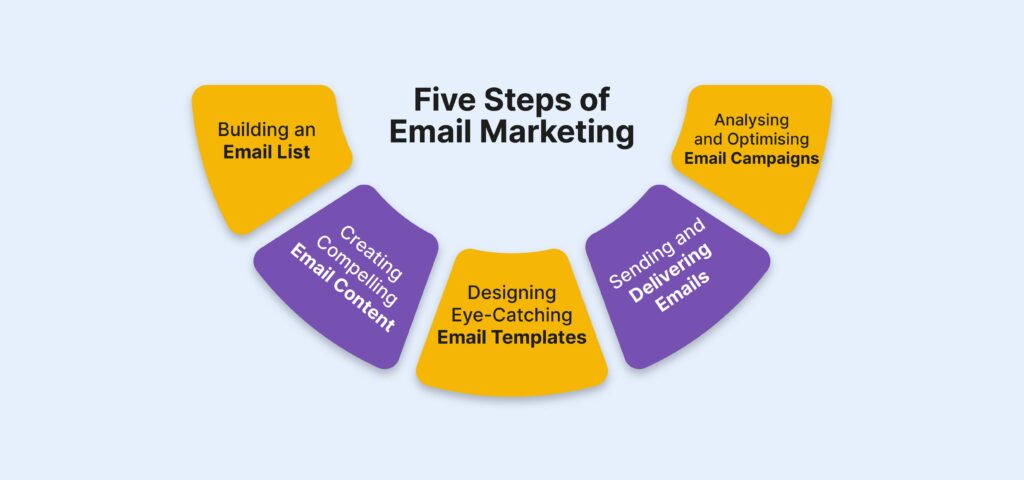
Now that we understand the benefits of email marketing, let’s explore the five essential steps to implement a successful email marketing campaign:
Step 1: Building an Email List
The journey begins with building a solid email list comprising individuals who willingly opt-in to receive communications from your business. You can entice them through website sign-up forms, offering lead magnets like free e-books, webinars, or exclusive content. Remember, obtaining explicit consent and providing an easy way to unsubscribe is essential. It’s all about building trust and maintaining a healthy relationship.
Step 2: Creating Compelling Email Content
Once you have a list of eager subscribers, it’s time to wow them with compelling email content. Customise your emails to cater to their individual needs and preferences. And interests. Share product updates, informative newsletters, personalised offers, or educational content that provides value. And remember the importance of captivating subject lines and well-crafted email copy. Your goal is to entice your subscribers to open and engage with your emails, right eagerly?
Step 3: Designing Eye-Catching Email Templates
Visual appeal matters! Design eye-catching email templates that align with your brand’s identity. Incorporate visually appealing elements like images, videos, and infographics to create an immersive experience. Oh, and remember to optimise your templates for mobile devices. We’re all aware of how frequently we check our emails on our smartphones. Make sure your emails look stunning, no matter the screen size.
Step 4: Sending and Delivering Emails
Now that your content and design are on point, it’s time to hit that “send” button—Utilise email service providers or marketing automation platforms to set up automated email delivery scheduling. Timing is crucial, so consider the best time to send your emails for maximum impact. And remember to segment your email list to ensure the intended message reaches the appropriate audience at the optimal time. Personalisation at its finest!
Step 5: Analysing and Optimising Email Campaigns
Once your emails are out of this world, it’s time to gather insights and refine your approach. Keep an eye on key metrics like open rates, click-through rates, conversion rates, and unsubscribe rates. These metrics provide valuable data to optimise your campaigns. Conduct A/B tests to experiment with subject lines, calls-to-action, or visuals. Learn, adapt, and continuously improve your email marketing efforts.
The Future of Email Marketing
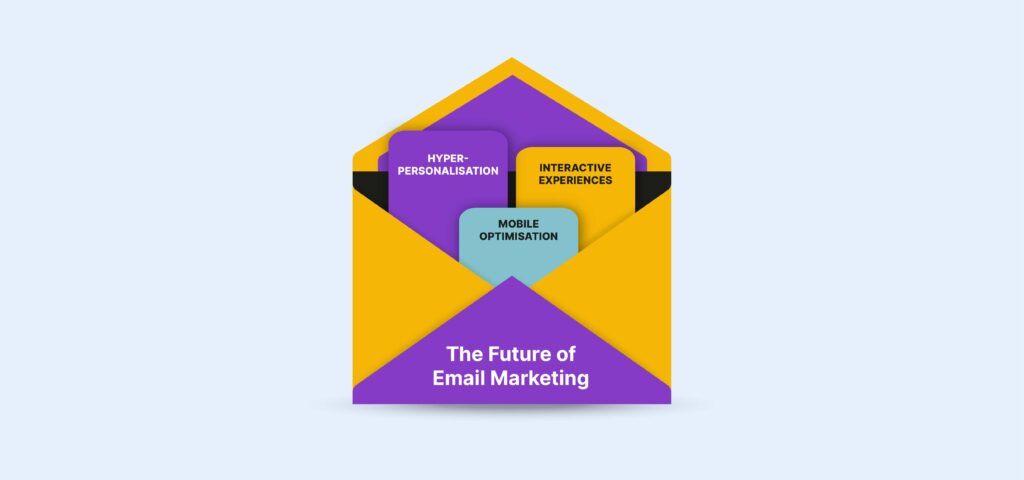
With advancements in technology, the future of email marketing holds exciting possibilities. Let’s take a sneak peek into what lies ahead:
- Hyper-personalisation
Imagine emails that are so personalised they feel like they were handcrafted for each subscriber. With advanced data analytics and artificial intelligence, businesses will deliver highly targeted and relevant content that meets individual preferences and needs.
- Interactive Experiences
Get ready for emails beyond text and images. Businesses will incorporate interactive elements like polls, surveys, quizzes, and gamification to encourage active participation. These immersive experiences will captivate subscribers and drive higher engagement.
- Mobile Optimisation
With smartphones becoming an integral part of our lives, businesses will prioritise mobile optimisation for their emails. Responsive designs and mobile-friendly content will ensure a seamless experience, no matter the device.
Emerging Trends in Email Marketing
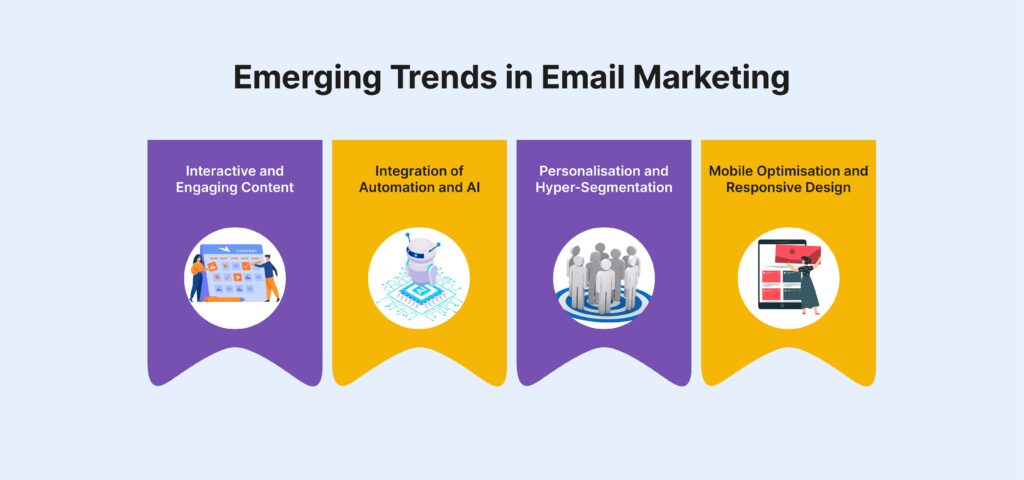
- Interactive and Engaging Content:
Email marketing is embracing interactive elements, such as dynamic content, gamification, and interactive surveys, to create a more immersive and personalised experience for recipients. These trends aim to make emails more engaging and interactive, capturing subscribers’ attention.
- Integration of Automation and AI:
Automation and AI technologies are being integrated into email marketing platforms, enabling advanced segmentation, personalisation, and automated workflows. This integration allows businesses to deliver highly relevant content based on user behaviour and preferences, enhancing the effectiveness of email campaigns.
- Personalisation and Hyper-Segmentation:
Personalisation remains a crucial focus in email marketing. By leveraging customer data and advanced segmentation techniques, businesses can send highly targeted and personalised emails that resonate with individual recipients. Hyper-segmentation takes personalisation a step further by dividing the audience into smaller, particular groups based on various factors.
- Mobile Optimisation and Responsive Design:
Optimising email campaigns for mobile has become essential with the increasing use of mobile devices. Responsive email design ensures that emails adapt seamlessly to different screen sizes, providing an optimal viewing experience for mobile users.
Why is Email Marketing Important?
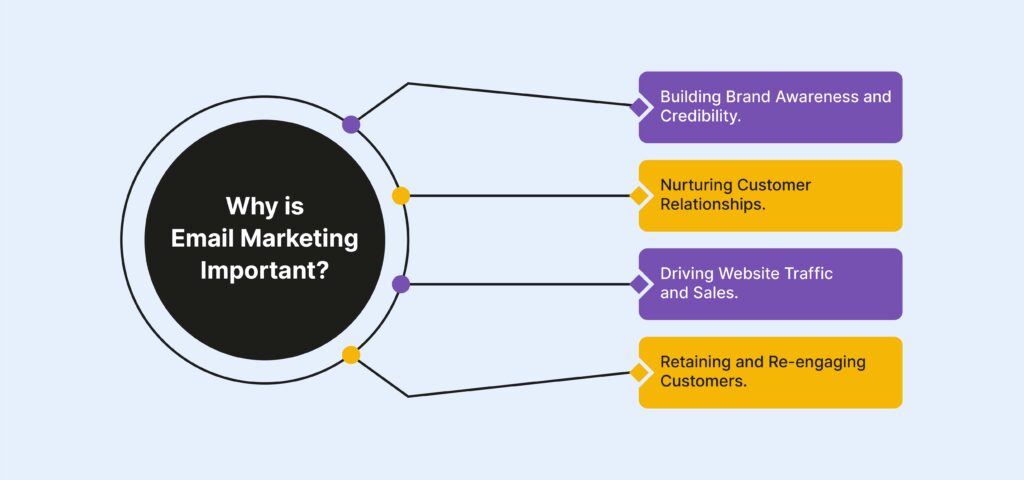
- Building Brand Awareness and Credibility:
Email marketing allows businesses to consistently deliver valuable and relevant content to subscribers, establishing themselves as industry authorities and building trust with their audience.
- Nurturing Customer Relationships:
By staying in touch with existing customers through email, businesses can foster relationships, provide updates, and offer exclusive deals. This helps strengthen customer loyalty and encourages repeat purchases.
- Driving Website Traffic and Sales:
Well-crafted email campaigns can drive traffic to a business’s website, increasing exposure and generating potential sales. By strategically including links to relevant pages, companies can guide recipients to take desired actions.
- Retaining and Re-engaging Customers:
Email marketing is effective for retention and re-engagement. By dividing the email list into specific segments and delivering personalised emails tailored to each component, it reaches the right audience, maximising engagement and response rates. Interested customers, businesses can reignite engagement and encourage repeat purchases.
How is Email Marketing Implemented?
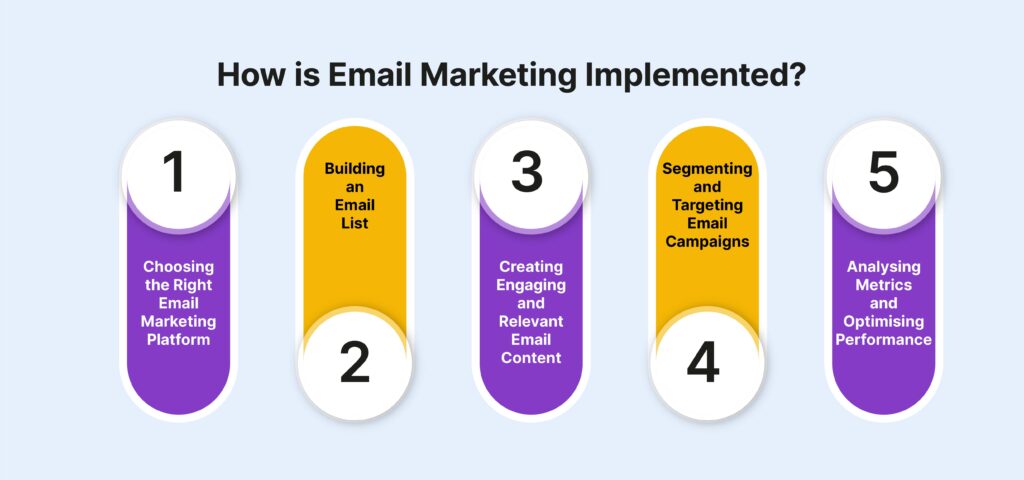
- Choosing the Right Email Marketing Platform:
Selecting a reliable platform like Mailchimp, Constant Contact, or Campaign Monitor is essential. These platforms offer features such as list management, templates, automation, and analytics to streamline the email marketing process.
- Building an Email List:
Businesses can make an email list by implementing sign-up forms on their website, utilising social media channels, or offering lead magnets to entice visitors to subscribe. Obtaining explicit permission and providing clear information about the content subscribers will receive is crucial.
- Creating Engaging and Relevant Email Content:
Compelling email content is crucial in capturing and retaining recipients’ attention. Businesses should focus on providing value, relevance, and personalisation in their emails through product recommendations, informative newsletters, or exclusive offers.
- Segmenting and Targeting Email Campaigns:
Segmenting the email list based on demographics, purchase history, or engagement levels allows businesses to send targeted emails to specific groups. Companies can improve open rates and engagement by tailoring the content to each segment’s preferences and needs.
- Analysing Metrics and Optimising Performance:
Monitoring email marketing metrics like open rates, click-through rates, and conversion rates helps businesses understand the effectiveness of their campaigns. Analysing these metrics enables enterprises to identify areas for improvement and optimise future email marketing efforts.
Conclusion
Email marketing remains a powerful tool in the digital marketing landscape. It offers numerous benefits, including increased customer engagement, cost-effectiveness, targeted communication, and improved conversion rates. By following the essential steps of email marketing and staying updated on emerging trends, businesses can leverage this strategy to establish brand awareness, nurture customer relationships, drive website traffic, and achieve their marketing goals. Email marketing continues to thrive alongside social media and instant messaging platforms, providing a direct and personalised way to connect with customers.


